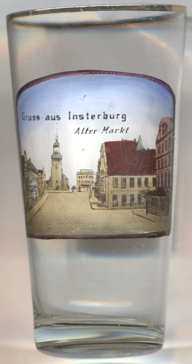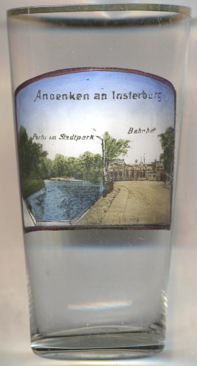

|
| РОССИЯ ROSSIJA | RUSSIA |
| Калининградская область / Kaliningradskaja oblast' | Kaliningrad province |
| Черняховскский район / Černjahovskij rajon | Černjahovsk district |
Черняховск (Černjahovsk), prior to 1946 known by its German name Insterburg (Lithuanian: Įsrutis; Polish: Wystruć) is situated at an elevation of 30 m at the confluence of the Instruč and Angrapa Rivers, forming the Pregol'a. The municipality has a population of about 40,400 (2010).
Černjahovsk was founded in 1336 by the Teutonic Knights on the site of a former Old Prussian fortification when
the Grand Master of the Teutonic Knights built a castle called Insterburg following the Prussian Crusade. During the
Teutonic Knights' Northern Crusades campaign against the Grand Duchy of Lithuania, the town was devastated in 1376 and then
again by Polish troops in 1457. The castle had been rebuilt as the seat of a Procurator and a settlement also named
Insterburg grew up to serve it. After the secularisation in 1525 of the monastic state of the Teutonic Order,
Insterburg became part of the Duchy of Prussia and was granted town rights in 1583. Insterburg became part of the Kingdom of
Prussia in 1701, and because the area had been depopulated by the plague in the early 18th century, Friedrich William I,
King in Prussia, invited Protestant refugees who had been expelled from the Archbishopric of Salzburg
to settle in Insterburg in 1732. In 1818, after the Napoleonic Wars, the town became the seat of Insterburg District within
the Gumbinnen (today Gusev) Region. Insterburg became a part of the German Empire following the
1871 unification of Germany, and in 1901 it became an independent city separate from Insterburg District. After World
War II and the Potsdam Conference in 1945, Insterburg as part of the northern part of
East Prussia was transferred from Germany to the Soviet Union. The German population was either evacuated or expelled and
replaced with Russians. In 1946, Insterburg was renamed Černyahovsk in honor of the Soviet World War II
General of the Army, Ivan Danilovič Černjahovskij, who commanded the army that first entered East Prussia in
1944.


The  Luther Church [left, no. 4639, and right, no. 3505: background]
on the former Old Market was built in 1610–1612 in place of an older church that had been mentioned already in 1537.
Until 1945 it was (since 1911 together with the Melanchhon Church) the Protestant church of Insterburg. Damaged in 1945,
the church was blown up and the site was leveled.
Luther Church [left, no. 4639, and right, no. 3505: background]
on the former Old Market was built in 1610–1612 in place of an older church that had been mentioned already in 1537.
Until 1945 it was (since 1911 together with the Melanchhon Church) the Protestant church of Insterburg. Damaged in 1945,
the church was blown up and the site was leveled.

The views depicted on glass no. 4640 [near left] show a view of the
 municipal
municipal railway
railway
[https://en.wikipedia.org/wiki/Chernyakhovsk, https://de.wikipedia.org/wiki/Tschernjachowsk;
https://de.wikipedia.org/wiki/Lutherkirche_(Insterburg);
https://de.wikipedia.org/wiki/Bahnstrecke_Tschernjachowsk%E2%80%93Sowetsk;
https://de.wikipedia.org/wiki/Bahnstrecke_Toru%C5%84%E2%80%93Tschernjachowsk]
![[scale]](lineal.jpg)